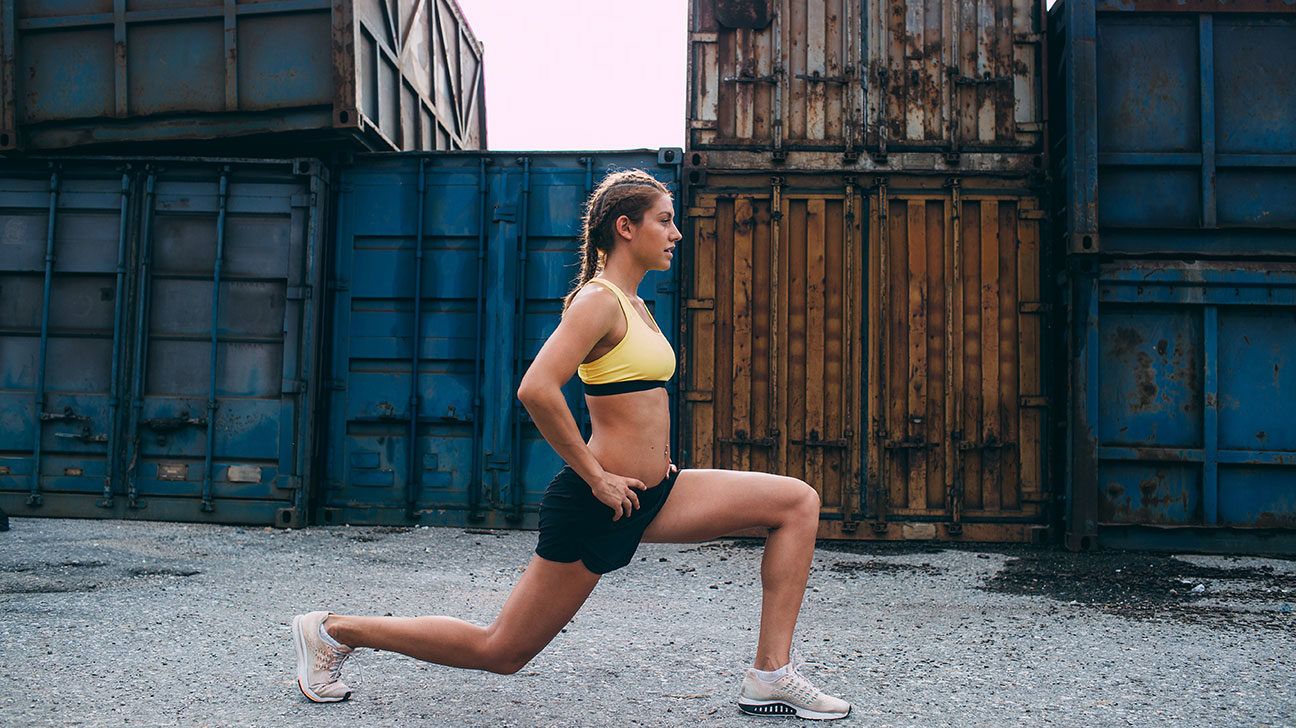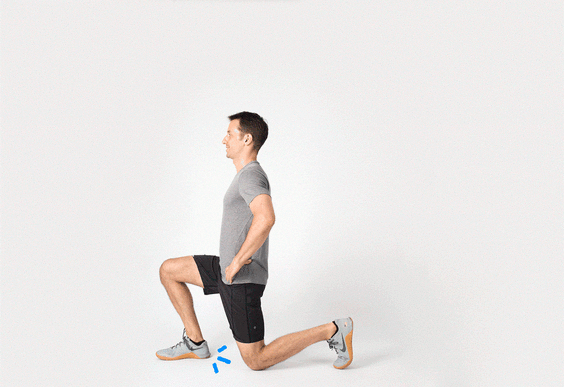If you’ve ever knelt down to tie your shoe or seen someone propose on a bended knee, you’re familiar with the lunge. A lunge is a single-leg bodyweight exercise that works your hips, glutes, quads, hamstrings, and core and the hard-to-reach muscles of your inner thighs.
Lunges can help you develop lower-body strength and endurance. They’re also a great beginner move. When done correctly, lunges can effectively target your lower-body muscles without placing added strain on your joints.
While studies on this quintessential exercise are limited, we did dig up a study on swimmers. In 2015, researchers figured out that those who warmed up with either squats or lunges had faster swimming times — not too shabby for such a simple exercise.
Ready to take the lunge? Master the move by following the steps below from personal trainer Greg Nieratka. Then keep reading to learn how to fix common mistakes and try some variations.
1. Stand tall with feet hip-width apart. Engage your core.
2. Take a big step forward with right leg. Start to shift your weight forward so heel hits the floor first.
3. Lower your body until right thigh is parallel to the floor and right shin is vertical. It’s OK if knee shifts forward a little as long as it doesn’t go past right toe. If mobility allows, lightly tap left knee to the floor while keeping weight in right heel.
4. Press into right heel to drive back up to starting position.
5. Repeat on the other side.
Tightrope lunge
Sure, lunges will challenge your balance, but there’s no reason to make it extra hard on yourself by narrowing your stance. Avoid bringing your front foot directly in line with your back foot, as if you’re walking on a tightrope. “This dramatically reduces stability,” Nieratka explains.
The fix: Start with feet hip-width apart and maintain that gap as you step.
Heel pop
We hate to break it to you, but “pop, lock, and drop it” should be reserved exclusively for the dance floor. When it comes to lunging, you’ll want to step forward enough so that your front heel won’t pop off the floor.
“If your step is too shallow, your knee will travel forward past your foot, which puts unnecessary stress and strain on the knee,” Nieratka says.
The fix: Take a larger step, plant your heel, and drive it into the floor to return to starting position.
Upper-body drop
With a forward lunge, it’s OK to, well, shift your weight forward. But beware of bending at the hip and letting your upper body drop, which will put added strain on your knee.
“This is especially important if you are doing a lunge under load or with a weight,” Nieratka says. If your chest falls, you run the risk of losing balance, falling, or even dropping the weight on yourself — ouch!
The fix: Engage your core. Think about pulling your belly button toward your spine. Also, keep your eyes forward instead of looking down.
Once you master proper form, you can add weight to make it more challenging — and rewarding. “The weight can be a barbell, one or two dumbbells, a kettlebell, or really any object you have at home,” says Nieratka.
Water bottles or a jug of laundry detergent totally counts too. Or try these lunge variations to switch up your routine.
Reverse lunge
Go easy on your knees with this lunge. Stand with feet hip-width apart, engage your core, and take a big step backward.
Activate your glutes as you bend front knee to lower your body so back knee lightly taps the floor while keeping upper body upright. Drive front heel into the floor to return to starting position. Repeat on the other side.
Walking lunge
Perform a forward lunge and walk it out. At the low point of the lunge, instead of returning to starting position, shift your weight forward and drive front heel into the floor.
Rise up as you bring back foot forward to meet front foot. Reset feet to hip width. Repeat on the other side as you continue to move forward.
Lateral lunge
From starting position, take a big step to the right with right foot, keeping toes forward and feet flat on the floor. Send hips back, shift weight into right heel, and extend arms in front of you for balance. Push off right heel to return to starting position, then repeat on the other side.
Curtsy lunge
With hands on hips and feet wider than hip-width apart, step left leg behind right leg. Bend right knee, engage glutes, and lower until right thigh is parallel to the floor. Lightly tap left knee to the floor. Drive right foot into the floor to rise to starting position. Repeat on the other side.
Clock lunge
Lunge in all four directions on each side. Lunge forward with right foot, lunge laterally with right foot, reverse lunge with right foot, and then curtsy lunge, bringing right foot behind you. Repeat on the other side.
Walking lunge stretch
Perform a walking lunge by stepping right foot forward. At the bottom of the movement, hover left knee just above the floor and twist from your hips to the right over right knee.
Place hands on knee to help deepen the stretch. Hold for 2 seconds. Press into right heel and bring left foot to meet right to return to standing. Repeat on the other side.
Split lunge jump
Stand with feet hip-width apart. Instead of stepping, jump into a forward lunge position with right foot forward. Drive right heel into the floor to explosively jump up.
Switch legs in midair so you land with left leg forward. Immediately lower into a lunge on the other side. For momentum, pump arms as if you’re running.
Special thanks to personal trainer Greg Nieratka for demonstrating these moves for us.



